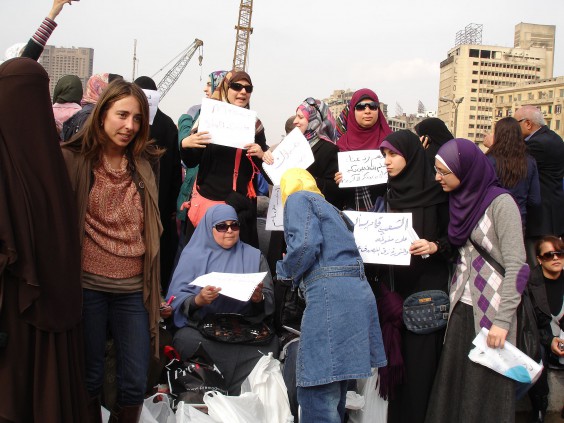The Dance
by Hamdy El-Gazzar and translated by Nancy Spleth Linthicum / June 16, 2014 / No comments
Egypt’s women and the new president.

Egyptian Women Against Mubarak. Photo: Wikimedia.
At the end of May, in front of a polling station where citizens had gone to cast their votes for the presidential election, were groups of women young and old, some uncovered, some wearing hijabs, and a few in niqabs. The song “Boushret kheir” by Emirati Hussain al-Jassmi, with lyrics by the Egyptian Ayman Bahjat Qamar, was playing while people danced. Governed by the beat of drums, it was a dance that was wholly eastern, an authentic and traditional Egyptian dance with a long history behind it.

- “From Egypt” attempts to draw a cultural map of Egypt and the Arab world by profiling the artistic, literary, and political issues that affect the region via on-the-ground coverage of current events, publications, and the fight for freedom of expression.

- Hamdy El-Gazzar is an Egyptian writer and one of the 39 young Arab writers included in the Beirut 39 Project. His first novel, Sihr Aswad (Dar Merit, 2005) won the prestigious Sawaris Award, and was subsequently translated by Humphrey Davies (Black Magic, AUC Press, 2007). His second novel, Ladhdhat Sirriyya (Secret Pleasures) was published by Dar al-Dar in 2008. He is currently working on a third novel.
Immediately following the official announcement of the election results (which came as no surprise) female journalists began to dance. In squares like Tahrir and Mohandiseen, on the asphalt and in the dust, in cars and on balconies, slender women and full-bodied women, young girls, mothers, and grandmothers all danced a long, solemn, hot dance.
Dancing in Egypt is an art as authentic as food like fuul, koshary, and the beer of ancient Egyptians. In dance our women blossom, their limber bodies eclipsing the music. Dance creates a kind of theater and each woman turns into the sole actor, alone on the stage with no secondary parts, assistants, or audience. Nothing but the voices of the musical instruments accompany her, and the singing urges her body to reveal its beauty and display its artistry. Whether the dance is performed on stage, in a film or video, or in real life—at weddings, circumcisions, exorcisms of jinn, or presidential elections—for our women it’s all the same. Dancing, as an expression of happiness, joy, and delight, is a feminine, Egyptian art. It’s like the wails, cries, and funeral songs of Egyptian women that follow coffins to the grave and in front of the gravestones of the dead.
The Egyptian woman was motivated by politicians to enter the political arena and brought with her her husband, son, and other relatives. She stands on the stage now as a hero, as the lead. Having brought all of her talents to bear in the election, she now takes part in her greatest craft: Dancing.
In my country dancing is a beautiful, joyful thing. Women dance at their sons’ and grandsons’ weddings and to welcome a newborn. They dance during a pleasant evening with their husbands and outside the room of a new bride and groom. But on that day at the end of May they danced for the people’s hero, the one who would awaken the country from its stupor and save it from its blackest days. They danced for their freedom to dance!
Dancing in my country is like an appetizer; it paves the way for a night of passion. On the day of victory, women young and old danced in front of the polling stations and invited the hero to enter the wedding chamber, saying to him: “Tonight is for joy and dancing! Delight us, O groom—grant us happiness, have compassion, show us how you are a man. Come, give us joy, for we gave you so much. Happily we danced with you and for you, so help us now. Grant us happiness and joy, O groom.”
The bridegroom said nothing in response, but entered the wedding chamber with a confident smile. Now the dancers, enamored, wait to see what he will do. Because of his position, standing, and prior actions, they see him as a choice groom. He recognizes the women’s importance in this scene and in life, and is familiar with the saying “great is women’s cunning.” As for the women, they know how angry and indignant they will become, how they will turn his life into a living hell, if he fails to give them what they desire, or disappoints their lofty hopes and their boundless dreams.
Yet in the end, as in the beginning, the dance is beautiful.




